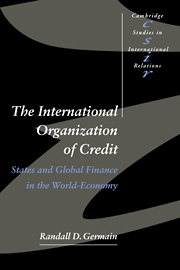Book contents
- Frontmatter
- Contents
- List of figures and tables
- Preface
- Note on figures and tables
- Glossary
- 1 Routes to international political economy: accounting for international monetary order
- Part 1 The international organization of credit in historical perspective
- 2 The power of cities and their limits: principal financial centers and international monetary order
- 3 Between change and continuity: reconstructing “Bretton Woods”
- Part 2 The contemporary international organization of credit
- Appendix: Top merchant/investment banks, by city and era
- References
- Index
- CAMBRIDGE STUDIES IN INTERNATIONAL RELATIONS
3 - Between change and continuity: reconstructing “Bretton Woods”
Published online by Cambridge University Press: 14 January 2010
- Frontmatter
- Contents
- List of figures and tables
- Preface
- Note on figures and tables
- Glossary
- 1 Routes to international political economy: accounting for international monetary order
- Part 1 The international organization of credit in historical perspective
- 2 The power of cities and their limits: principal financial centers and international monetary order
- 3 Between change and continuity: reconstructing “Bretton Woods”
- Part 2 The contemporary international organization of credit
- Appendix: Top merchant/investment banks, by city and era
- References
- Index
- CAMBRIDGE STUDIES IN INTERNATIONAL RELATIONS
Summary
1947 stands as a watershed in terms of the structural transformation of the international organization of credit. Between the wars, the private London-centered global credit system that had so effectively supported the nineteenth-century world-economy proved impossible to reconstruct in its entirety: its capital recycling mechanism remained only imperfectly operative during the 1920s; international clearance centered on London broke down completely in 1931; and throughout the 1930s the very possibility of creating a network through which international credit could pass was stillborn. Immediately after 1945 the task of resurrecting effective international banking networks proved equally difficult, precisely because the international dimension of credit – as a material resource as well as a set of social practices – had itself to be reconstituted. This required finding new sources of internationally mobile capital and re-establishing the means of transferring it abroad. In other words, a new international capital recycling mechanism had to be constructed. This was made possible only through the active intervention of public authorities, who took it upon themselves to reverse a decade and a half of inadequate private capital recycling. The story of the Bretton Woods era, therefore, revolves around the ways and means in which public authorities worked to re-establish a global credit system consistent with the domestic aims and ambitions of those states with the strongest and most important postwar economies.
Once established in the years after 1947, however, the structure of the international organization of credit proved extraordinarily resilient. In fact these foundations proved so sturdy that documenting the definitive end of the “Bretton Woods” era in 1971 is a slightly disingenuous exercise, for many of its foundations remained solidly intact throughout the 1970s and indeed ended only in the 1980s.
- Type
- Chapter
- Information
- The International Organization of CreditStates and Global Finance in the World-Economy, pp. 75 - 100Publisher: Cambridge University PressPrint publication year: 1997



